Likes: everything you need to know about dogs
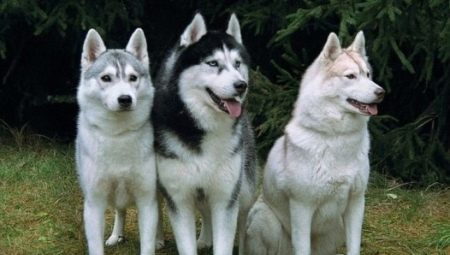
Likes are insanely popular and beautiful dogs, famous for their high level of intelligence and energy. Many people choose this breed because its representatives are unpretentious in their care. They make loyal and devoted friends of a person. Today we will take a closer look at this world famous breed and learn all about the features of its content.
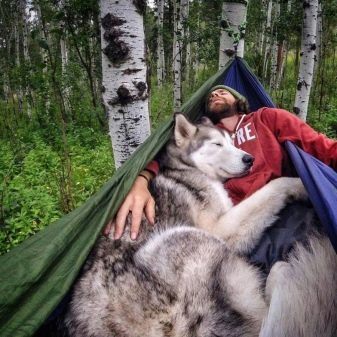

Origin story
Likes are known all over the world, but not everyone knows the history of their origin. This breed is one of the oldest. Such dogs are of the hunting type. They came from the Russian North and Siberia. Representatives of this species have been forming for many hundreds of years, being in the harsh conditions of the not most hospitable tundra and taiga.
Until the beginning of the 19th century, there were practically no mentions of likes. At that time, they were considered the simplest dogs that did not need special and complex care. From the very beginning, huskies were distinguished by their independence. These were service animals that were suitable for various types of service. In hunting with huskies, no one could compare.
The ancestors of modern huskies, as we know them, were widespread throughout Russia. These individuals had a fixed, characteristic exterior. They were characterized by medium height, thick and solid wool, high pointed ears (thanks to this characteristic, Laikas were called “sharp-ears”).
The specimens, which are not distinguished by hefty strength and endurance, took part in an old Bavarian game - bear hunting.
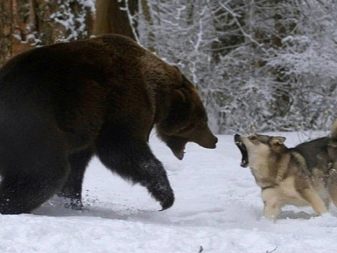
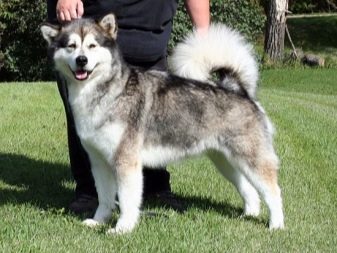
Animals of this breed were kept in free conditions. The purity of their blood was not monitored at all - it was not important at the time. As a result, this led to the inevitable mixing of different breeds. Because of this, the characteristic appearance of the huskies was lost. The purebred ancestors of modern huskies could be found exclusively in the Far North. In those parts a lot depended on huskies, including the survival of a large number of nationalities.
For the Nenets, Chukchi, Eskimos, Yakuts, the varnishes were and still remain impeccable assistants, whom no one can replace. From dogs of this breed, unsurpassed skillful hunters, guards, shepherds are obtained. Likes are often used as a source of the necessary heat. The purity of the population was maintained through very strict selection. Too weak, overly aggressive, not the most intelligent and cowardly individuals were simply exterminated.
Constant mixing with wolf blood has led to the formation of a truly unique breed of hunting four-legged - powerful, hardy and courageous.
There are many subspecies of huskies. The most widespread and well-known today are the West Siberian dogs. These animals are the result of crossing the Khanty and Mansi species. Once upon a time, such dogs were the "right hand" of shepherds. They helped humans survive in harsh natural conditions.
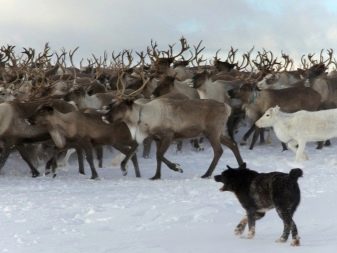
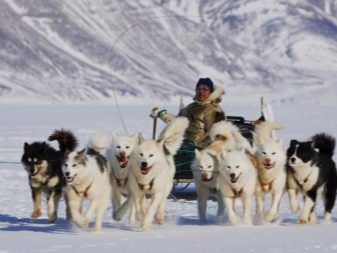
Description
Currently, huskies are considered one of the most famous and popular dogs. They are real workers, capable of performing a wide variety of services. Smart, fast and independent pets are the dream of many dog lovers.
If you want to acquire such an intelligent and loyal friend, then you should pay attention to the main characteristics of the representatives of the described breed.
- In dogs of all varieties, the head is distinguished by a special wedge-shaped structure.
- All huskies have high set ears with sharp tips. They never hang.
- Another characteristic feature of this breed of dogs is the tail in a ringlet.
- The hair of huskies is very stiff. The coat is straight, without curls or waves. The undercoat is solid and thick (it is thanks to him that huskies easily endure the effects of low temperatures, without experiencing discomfort).
- In the neck area, the coat turns into a voluminous shaggy collar.
- The skeleton of huskies is very strong and powerful. The musculature is well developed. Psam is characterized by stately correct posture.
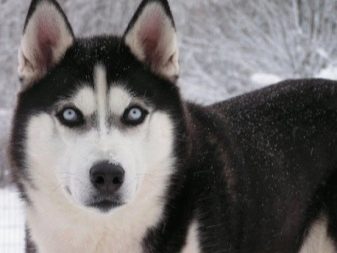
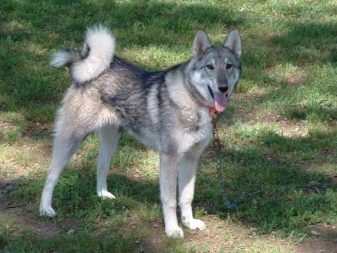
The characteristics of adult dogs of different types of huskies may differ. This applies to the height and weight of the animals.
- Western Siberian individuals usually weigh from 18 to 23 kg in adulthood. Their approximate height is capable of reaching 53-58 cm.
- No less common Yakut huskies weigh 23-30 kg. Their height is 53-56 cm.
- East Siberian animals weigh from 18 to 23 kg and grow to 56-64 cm.
- The Russian-European variety of husky weighs 20-23 kg, and its average height is 53-38 kg if it is a cable. If we are talking about a bitch, then her weight will range from 48-56 kg.
- Karelo-Finnish species of northern dogs weigh from 12 to 13 kg for males, and 7-10 kg for females. The growth of the male is 42-48 cm, the bitch is 40-46 cm.
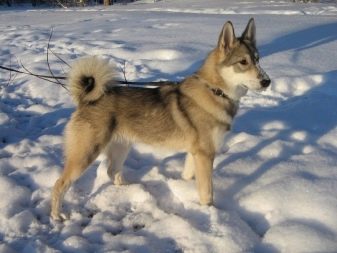
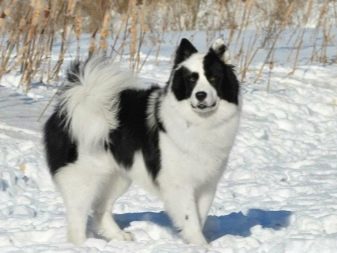
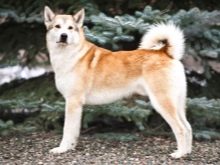
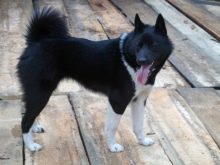
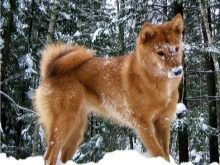
The coat of individuals of this breed is of medium length. In the area of the neck and shoulders, the coat grows more voluminous and thicker, due to which the chic warm collar mentioned above is formed.
The coat color of huskies can vary significantly. In most cases, there are carriers of a mixed type of color, as well as a gray-white or red coat. With these colors, the nose will have a characteristic black color. If the pet is white-brown, then its nose will be light brown.
At all stages of life, representatives of the northern breed look very beautiful. They are like wolves.


Character
Any of the varieties of huskies should be started only after a detailed acquaintance with the peculiarities of the character of this breed.
All huskies are freedom-loving and independent animals, accustomed to acting in their own interests and considerations. However, these qualities do not prevent the representatives of the northern breeds from demonstrating humility and devotion to their beloved owner. A healthy purebred husky will not show impudent and obsessive behavior, but these pets are not used to behaving like weak-willed creatures.
Likes are connoisseurs of justice. If this is not the case, then such dogs will certainly demonstrate to the owner their dissatisfaction with the current situation.
All likes are characterized by inordinate curiosity. If you walk such an animal without holding it on a good leash, it can suddenly break loose and run away.covering impressive distances. If the object of the hunt is related to small game (for example, marten, weasel or squirrel), then the dog will behave in a standard way - using the sense of smell, he will find his target, will follow it, and then press down and bring it to the hunter.
Usually, likes do not behave with excessive aggression. They resort to such only in exceptional situations. If necessary, such a dog will demonstrate tremendous strength, which many do not expect from him.
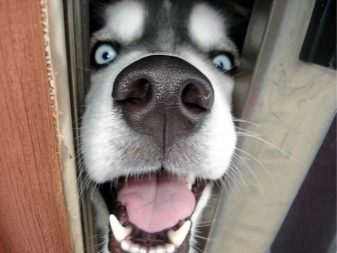

Laika is a wonderful family dog. Such a pet will be good-natured and friendly to all family members, without showing aggression or anger. These animals are especially fond of children. Usually, likes react calmly when guests come to the house. In such conditions, they do not show unrestrained joy, but anger does not come from them either. But the dog will always keep the situation under strict control. If necessary, the animal will react with lightning speed.
Any subspecies of Laika is characterized by a rich coat. Thanks to this, representatives of this breed feel great, even if they are in severe frosty conditions. True, these dogs do not really like the heat. Most often, such pets are kept on the street, in city apartments - much less often.
Likes are not only excellent hunters, but also consummate watchmen. They will behave aggressively only when they feel that the owner is in real danger.
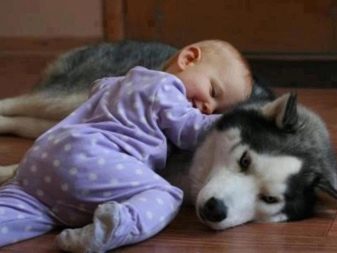

Dogs of this famous breed love companionship. Attention to their own person gives them great pleasure, therefore, it is necessary to closely and constantly contact with such a pet so that he does not get bored and does not feel lonely.
Before starting a husky, you must take into account that such dogs are talkative. These dogs are very sensitive and touchy, so the owner and members of his family should not shout at such a pet or punish him physically. Such actions can lead to the fact that the dog ceases to trust the person, and this is not good.
Despite the fact that the likes are obedient and persevering, this does not prevent them from being stubborn and persistent in their aspirations. Such dogs are able to quickly assess different situations and make decisions on their own. However, the authority of the owner at such moments remains in the first place among the huskies.
Such pets are great lovers of play. They love to jump, run, they are happy to carry out commands given by the owner. Even if the latter turns out to be incorrect, the animal will still perform it contrary to its instincts.
During the hunt, the husky will be the leading person. At such moments, these animals understand why this or that action is required. They will allow the owner to make a shot directly at the target, diverting all the attention of the object. Likes never hunt just for themselves. They are not particularly interested in this. Such animals work exclusively for humans. If there is a dangerous and unforeseen situation, the husky can sacrifice itself without hesitation.
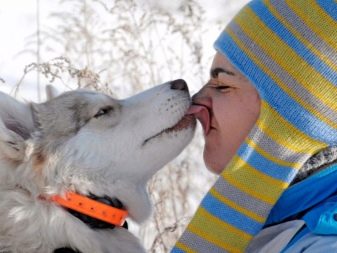
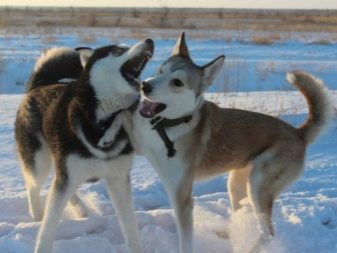
Hunting with a husky
Hunting with a husky is a pleasure, since these dogs are among the best hunters. They boast incomparable delicate instincts, perfect hearing and the same vision.
Likes are not big fans of chasing prey throughout the forest. They try to drive her directly to the hunter. Such a pet can give a voice only if it has spotted the game. These famous hunting tetrapods are suitable for pursuing not only small objects, but also large ungulates or even predatory specimens. Laika can hunt bear or lynx without any problems.
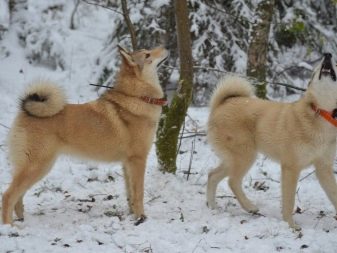

Life span
Many breeders are interested in how many years the dogs of this northern breed live. The average lifespan of a husky is 10 to 13 years. Much depends on the conditions in which the pet lives. If he is provided with the necessary care, he realizes himself in his favorite activities, and does not sit around the clock in four walls and eat right, then he can live longer.
Laikas, like representatives of most other known breeds, are susceptible to certain hereditary diseases. These pets should be regularly shown to the veterinarian, all the necessary preventive procedures and vaccinations should be carried out.
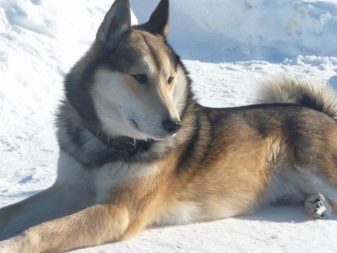
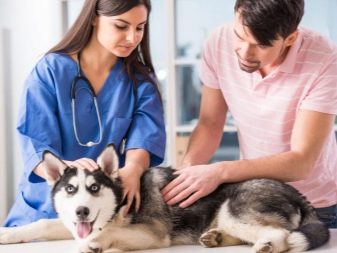
Breeds
Representatives of different breeds are called Likes. Each of them has its own characteristic features and external characteristics. Let's get to know them better.
By standards
There are several separate groups of Laikas, adopted at the official level. So, Russian factory breeds include:
- Russian-European;
- East Siberian;
- West Siberian;
- Karelian-Finnish huskies.
There are also Russian aboriginal species of breeds, which include:
- Nenets;
- Yakut;
- Evenk dogs.
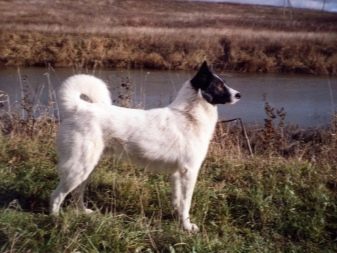
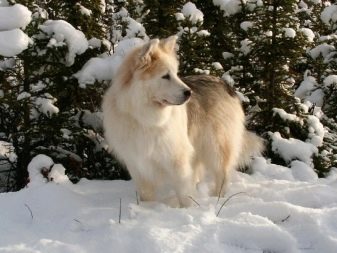
Collected in a separate category European breeds. This includes:
- Finnish Spitz;
- Karelian bear dog;
- Norwegian Elkhund gray and black;
- Norwegian Bukhund;
- norbotten spitz;
- yamthund;
- Swedish Elghund white;
- helleforshund.
Representatives of each of the listed breeds have many distinctive features inherent in them from nature.
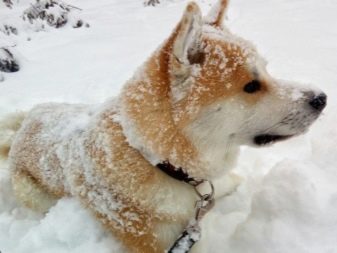
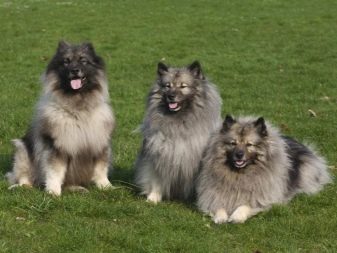
Russian-European
Russian-European huskies are distinguished by their strong constitution. They have well-developed muscles. At the withers, the average height of an adult reaches 52-57 cm.
These are hunting dogs. They were taken out in 1947 to the USSR. The breed was obtained by merging different types of huskies. These animals usually have a beautiful black and white color. They are used to leading an active lifestyle.
The color of a dog of this breed may differ in a different ratio of the two mentioned palettes. Simply put, the percentage of white and black will not necessarily be the same. There are dogs completely covered with black hair, but at least one snow-white spot will still be present on it.
The tail of these huskies is unfolded to its full length. It can be bent with a ring or a sickle. It often lies on the dog's thigh. If the pet is in a calm state, this part of the body may be lowered, although initially set high.
The coat of the Russian-European dogs is distinguished by a very coarse structure. Straight hair. There is a soft and dense undercoat. On the neck, withers and shoulders, the wool is more luxuriant, forming a chic warm collar, like most other huskies. The pubescence of the tail is uniform and visible along its entire length.
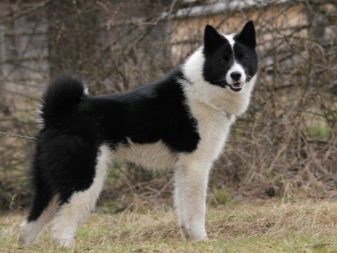

West Siberian
Representatives of this breed are versatile. They are recognized as the most numerous. This breed was formed in the middle of the 20th century. Since its representatives initially had a very attractive and effective appearance, they quickly gained great popularity all over the world. They attracted West Siberian huskies not only by their appearance, but also by their wonderful hunting qualities. They were used to hunt fur-bearing, large ungulates and even predatory animals.
West Siberian huskies in their appearance borrowed a lot from their ancient ancestors. They are of medium to tall height. The physique of such huskies is dry, but harmonious, dense, well-coordinated. The skeleton of West Siberian huskies is very strong. Males of this breed are easily distinguishable from bitches. They are larger and much more muscular. Females are more graceful and neat, do not have large and noticeable muscles. The withers of such dogs are well developed. Their tail is curled into a ring and lies either on the back or on the thigh.
In these pets, the coat is dense and very tough. The hair does not curl and does not curl - it is perfectly straight. A thick and solid undercoat is characteristic. The West Siberian tetrapods are characterized by a snow-white, zonal-ash, red, brown or dark black color. White spots are allowed on red wool.
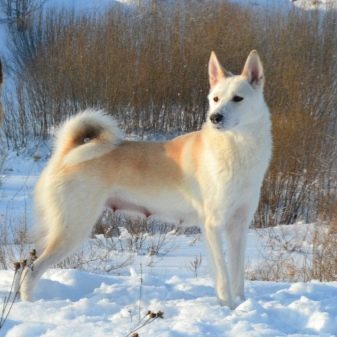
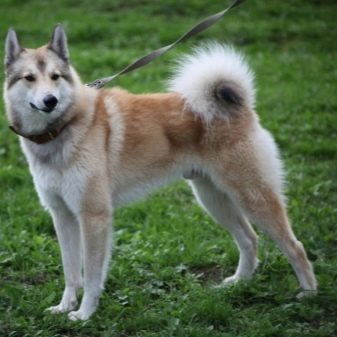
The nature of the West Siberian huskies is as calm and balanced as possible. Despite the natural calmness, they remain mobile and active. Such a pet is unlikely to want to vegetate within four walls.
Representatives of this species are not as reckless as their counterparts. However, they are ahead of the rest in terms of endurance and working capacity. They are unpretentious in their care - fabulous sums do not go to their maintenance. These animals have an amazingly developed orienting instinct. They are characterized by a high level of intelligence and an active instinct for self-preservation.
Such animals treat people with great kindness and friendliness. They easily and happily make contact with a person. They are able to fearlessly protect their family members from any enemies. Other pets, with which they grew up and live in the same territory, are treated normally, without unnecessary aggression. As for wild and unfamiliar pets, the West Siberian Laika is always hostile to such "persons".
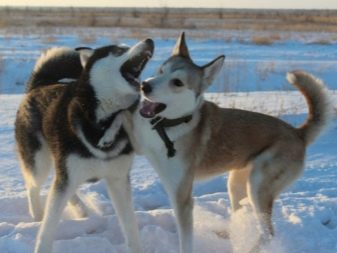

East Siberian
These are the largest representatives of hunting breeds. They are also used as sled dogs. The first information about these animals dates back to the 19th century, when the development of Siberia and the Far East took place.
They are intelligent and powerful dogs with well-developed withers, straight back, scissor bite and tail curved in a ring. The latter either lies on its back or rests on the thigh of the animal's body. Colors typical for this type of dogs:
- black;
- White;
- black and tan;
- ginger;
- brown (all shades of this color are allowed).
If the coat of dogs of this breed is blue, marble, black-backed or brown, then this means that there is interference from other breeds.


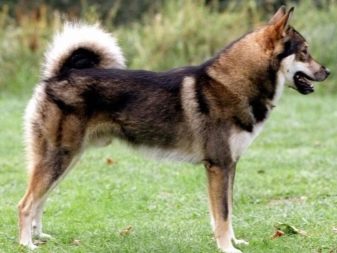
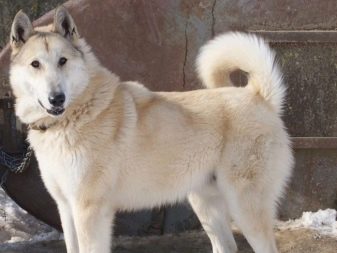
The movements of the East Siberian huskies are light, but fast. As a rule, they move at an accelerated trot or light canter.
These dogs have a very good temperament. They are ideally human-oriented. They are distinguished by an unbridled hunting passion. East Siberian huskies are balanced and adequate animals. Most representatives of this breed do not treat a person with anger or hostility, however, in certain territories they are often used as fearless and intelligent watchmen. Such pets are not afraid of hard work, as they are adapted to it. They are not afraid of harsh climatic conditions.


Karelian-Finnish
Dogs of this breed are recognized as the offspring of the Old Karelian Laikas, famous for their impeccable hearing and the same instinct. These animals were considered excellent bugbears.
Karelian-Finnish huskies are 50 cm tall if it is a male and 45 cm if it is a female. The weight of these animals can reach 12-15 kg. They are not very large and do not look intimidating. Despite this, Karelian-Finnish huskies are unsurpassed hunters. They can even hunt such large animals as wild boars and other ungulates in the forest.
Representatives of this breed are considered rare and not very common.They are characterized by a kind and playful disposition. Such likes are very cheerful and active.
The coloring of the muzzle of the Karelian-Finnish dogs is light, soft honey. There are also individuals with a dark honey muzzle. The eyes of these cute creatures can be black or brown.
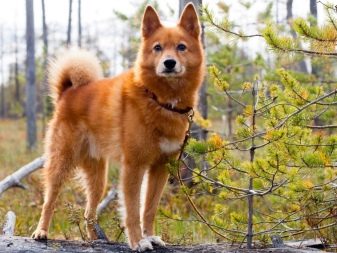
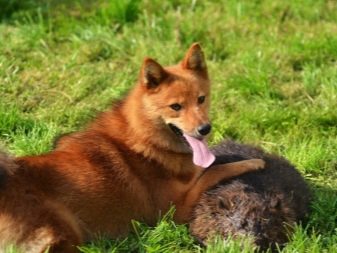
Russian aboriginal
Likes belonging to this category are ancient and bred literally in primitive conditions. To a greater extent, these animals "reached" our times, without undergoing significant changes. The indigenous peoples ensured a strict selection for the Russian aboriginal dogs, as a result of which a stable and balanced psyche, characterized by mobility, became characteristic of them.
There are several of the most famous Russian aboriginal Laika breeds. Let's get to know them better.
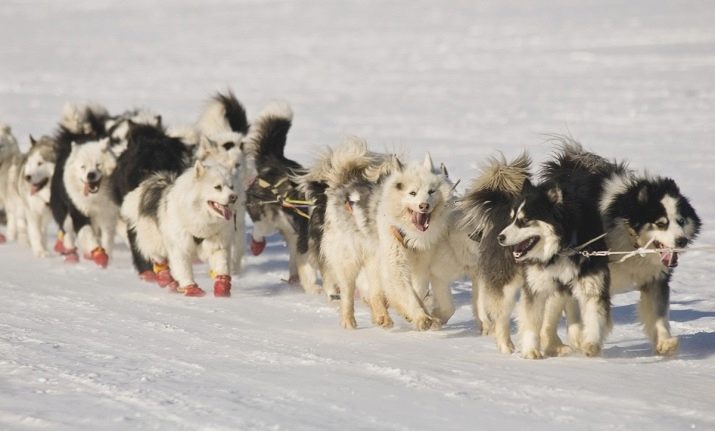
Nenets
In another way, this husky is called a reindeer herding spitz. This is a primitive native breed. It was formed in the conditions of the European tundra-steppes during the severe ice age. As soon as the glacier “surrendered” and retreated, these animals widely and quickly spread throughout the tundra and forest-tundra of Eurasia.
Usually, ancient Nenets dogs are used as smart and skilled shepherds or adventurous hunters. Slightly less often, the help of these pets is turned to the Ministry of Emergency Situations. Nenets huskies can be great hiking companions and just good family friends. On the territory of Russia, representatives of this breed are rare, although it is here that their second homeland is located.
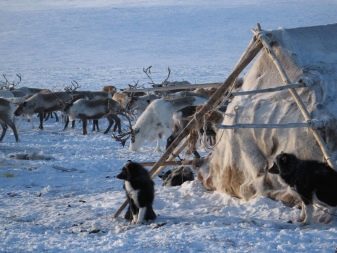
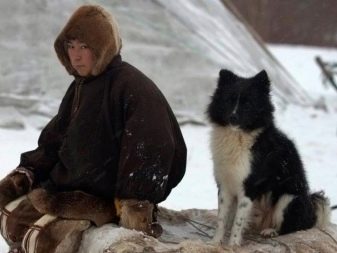
These small animals are spitz-like. Their growth is small - below average or average. Their body structure is dry, although strong. Nenets huskies do not look powerful and large. Males of this breed are more massive and stronger than females. They are characterized by a well-developed woolen cover, which lasts not only in cold seasons, but also in summer.
These animals are ambiguous in their behavior. They can demonstrate excessive rudeness or, conversely, zealous with tenderness. It all depends on the character and upbringing of such an interesting aboriginal pet.
The height of males according to the standard can be from 44 to 52 cm, and bitches - only 40-45 cm. There are slight deviations from the indicated values (no more than a couple of centimeters).
The characteristic coat colors of the Nenets dogs are as follows:
- ginger;
- Gray;
- brown (the level of saturation of this color may vary);
- White;
- black.
You can meet tan and spotted individuals - these colors are derived from those listed above.

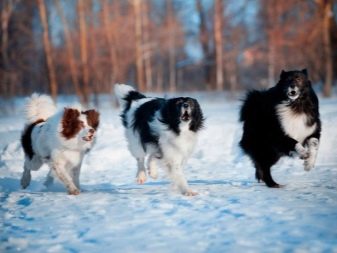
Nenets dogs are very mobile, but adequate and balanced. They are characterized by emotional and very lively behavior. They are characterized by self-confidence, good and quick reactions. Nenets huskies are strongly attached to their "educator". They behave affectionately, learn new teams without unnecessary problems and hassle. Tough methods of training for these pets are not required.
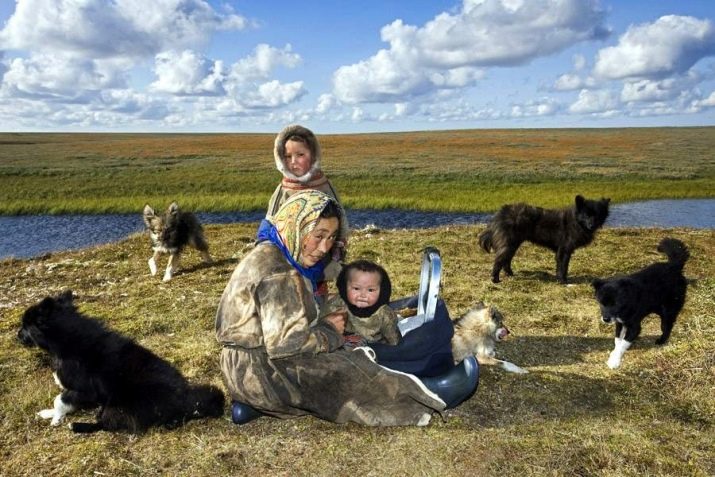
Yakutsk
Another ancient aboriginal breed. It was bred by the indigenous peoples of the northeastern part of Russia. These dogs figure in many myths and legends. These animals were treated extremely positively, with respect.
Representatives of this breed are distinguished by a strong physique, developed muscles. Yakut varnishes are not very large in size. They are medium and compact, with moderate growth. Their coat is well developed and allows these dogs to live and work in a harsh frosty climate. Males are more powerful and muscular than females. They are easy to distinguish from each other.
These animals can be of any spotted color. The monochromatic color of the coat is considered a defect. The only exceptions are those cases when it comes to white color.
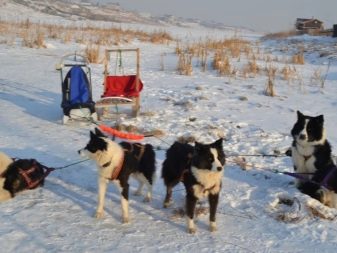
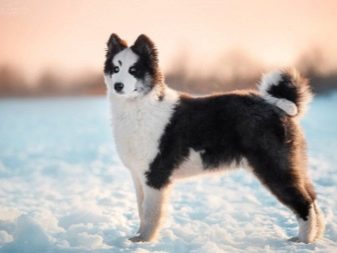
Evenk
Representatives of this ancient breed are excellent hunters. They can hunt not only small game, but also large animals. These animals showed themselves especially well in the elk hunting.Such a dog is able to single-handedly detain the animal until the hunter reaches it.
The Evenk Laika is a very intelligent, independent and quick-witted dog. The appearance of these animals is fox-like. They are of medium size. They are characterized by special caramel colors of the wool cover. Dogs of this breed are loyal to their owners. They make wonderful companions and assistants in different types of fishing.
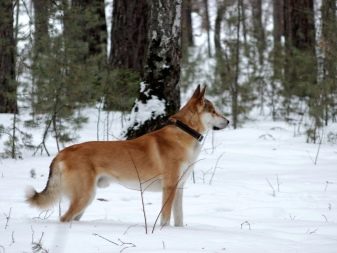
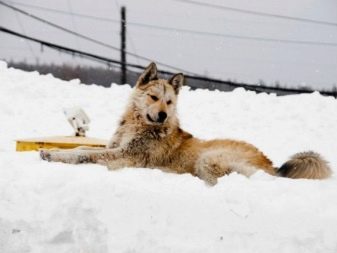
European
We should also talk about European Laika breeds. So, the famous Finnish Spitz descended from aboriginal individuals and has a characteristic dark red coat color. These pets inhabited the territory of Finland and present-day Karelia. They were originally useful in hunting birds and other animals.
These smart creatures are characterized by independence and the ability to make quick decisions. They are independent like any other hunter. The Finnish Spitz is not a very large and ferocious animal, but it behaves fearlessly and bravely. This pet will love his family with all his heart. Spitz are loyal and love to communicate with the owner.
Finnish Spitz are active and agile dogs. They love to run and play in a spacious area. This pet will quickly and easily find a common language with younger family members. But these dogs treat strangers with great suspicion and apprehension. They have a very sensitive ear, so they can become wonderful home keepers.
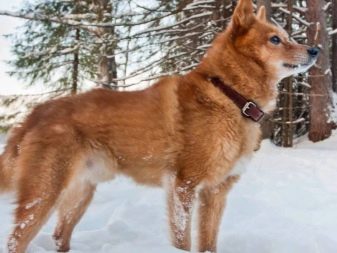

The Karelian Bear Dog is a wanted husky. Since ancient times, she accompanied hunters in their hunt and could hunt large animals, for example, bears, elks or wild boars. These animals are characterized by endurance and unpretentious care.
This breed was bred in Finland. According to external data, it looks like a Russian-European husky. Karelian bear pets are of medium size. Their body is slightly elongated. There is a well-developed strong skeleton.
The bear husky is very cruel and merciless towards its prey. Similarly, it applies to other pets. Even the Karelian dog can treat its relatives with pronounced aggression. For this reason, these animals need early socialization and correct upbringing.
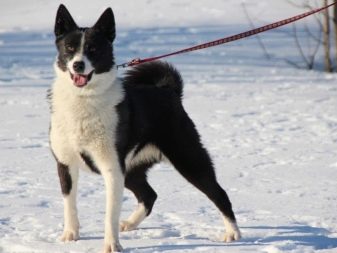
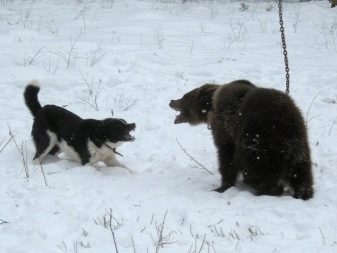
Such likes are very careful with strangers. They do not approach strangers, always keep at a safe distance, but do not show unnecessary aggression unnecessarily.
It is desirable to keep such a pet in a spacious enclosure. As a watchdog, the Karelian Bear Laika is not suitable for use due to its aggressive nature. However, she can always warn the owner of the danger by barking.
It is not recommended to buy a Karelian Laika puppy if this is your first such animal. With her, you will have to be as strict and restrained as possible. True, shouting and hitting such a pet is not allowed, although it behaves in a peculiar way.
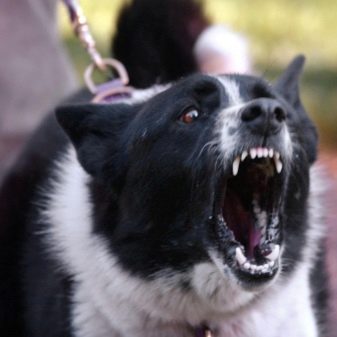
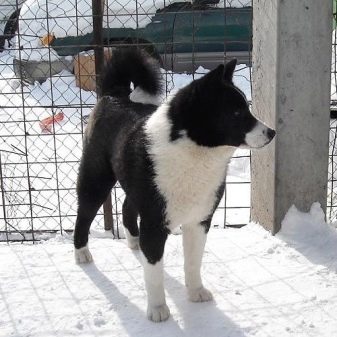
The Norwegian Elkhund (gray and black) is a good hunter. It is compact in size and its body has a characteristic square shape. The physique is proportional. Their height at the withers can range from 46 to 51 cm.
Dogs of this breed are very friendly and sociable. They are kind and smart, suitable for family life. Such a pet will become an excellent friend and guardian of the home in which it lives. These dogs are energetic and active, their disposition is distinguished by independence and self-esteem. You have to be firm with the Norwegian husky. She needs to be shown who is in charge in the house.
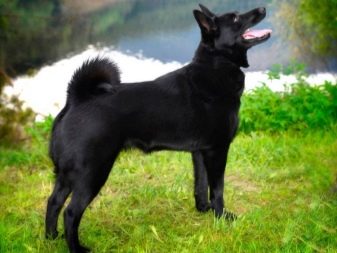
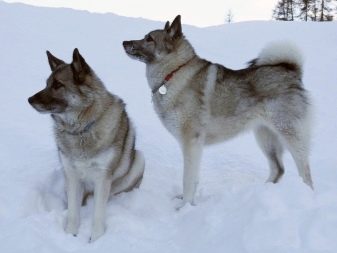
The Norwegian Buhund is also called the Norwegian Shepherd Dog. This is an interesting spitz-like breed that was bred in Norway. Its representatives are used as good watchmen, and as shepherds, and as companion dogs.
These pets belong to the "mini" size class, since their dimensions are smaller than average. At the withers, a male dog can only grow up to 47 cm, and a bitch up to 16 cm.
The character of these animals is truly Scandinavian.They have a strong hunting instinct. They are reliable, loyal and intelligent animals. In dealing with a person, the Norwegian Bukhund is friendly and sociable. Can communicate with children without any problems. Bukhund in general love to spend time in a company with a person. They are not aggressors by nature. They behave obediently. It is not difficult to educate them - the owner will not have to show physical strength in such matters.
Males are considered more loyal than females. And they behave as affectionately as possible. Females are restrained and low-emotional.
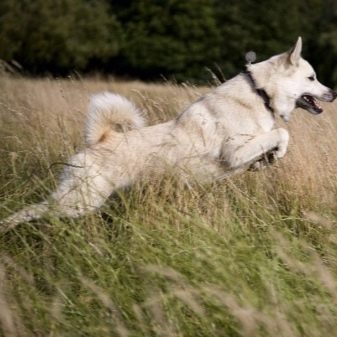

Norrbotten Spitz is another representative of the hunting breed. This is the smallest type of likes. It is used for hunting birds and fur-bearing animals. With their voice, they are able to restrain the moose. Such a spitz is also suitable for guarding the house. Many people keep these dogs in order to acquire a kind and intelligent companion.
These dogs are small, but their musculature is well developed and noticeable for its relief. Norrbotten is distinguished by quick-wittedness and complete self-confidence. At the same time, his disposition is cheerful and kind. The vigilance of these dogs never sleeps. They are mobile, but reasonable in their actions. They are good watchmen who can defend their territory. They love children and play with them.
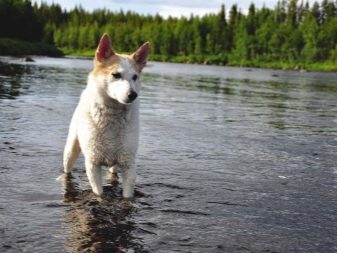
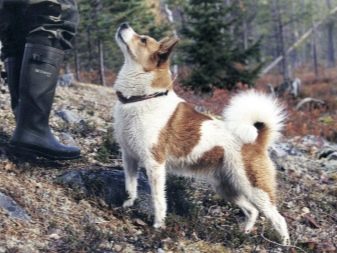
Yamthund are dogs that were bred specifically for hunting elk. They are spitz-like, but massive. Their growth is above average. Yamthunda are fearless, brave and brave animals. They are loyal to their masters, but do not forget to behave stubbornly. Such a pet demonstrates affectionate habits and loves to communicate.
Yamthund behaves openly aggressively with strangers. They are insanely kind and welcoming to their own family. True, these dogs love to show themselves as leaders and dominants. The owner must fight these habits in the early stages of the pet's growth.

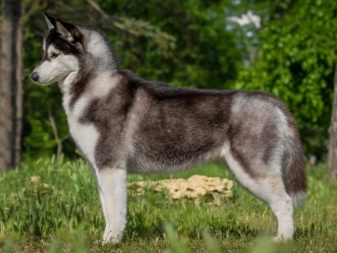
The Swedish Elghund is another hunting breed of Laika. She was taken out in Sweden. Representatives of this breed are of medium size. Their physique is not very rough. It is characterized by smooth lines and transitions, there are no angularities here.
The Swedish Elghund is a pet with a very good character. He is one of the greatest assets of these purebred dogs. Such likes are balanced and adequate. Keeping them at home is not as difficult as it might seem at first glance. They are incomparable hunters - bold and assertive.
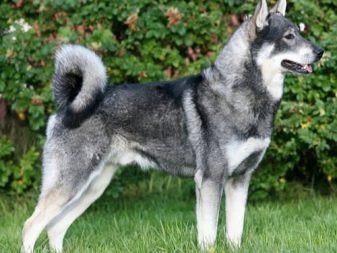

Sweden is the birthplace of the husky, belonging to the Helleforshund breed. These are animals known for their stubbornness. They are loyal to their masters and behave with the utmost calmness. It is not necessary to keep them in a simple city apartment - these dogs are not intended for such conditions.
It is a medium sized Pomeranian with a rectangular body shape. The tail of these huskies is sickle or curly. These dogs behave very actively and energetically. They are mobile and love to run. The Helleforshund are known for their strong and strong-willed character, as well as their fearlessness and resilience.
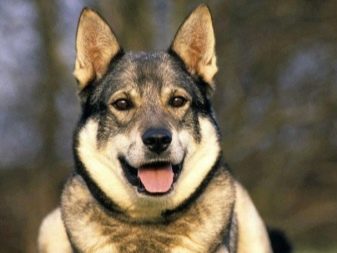
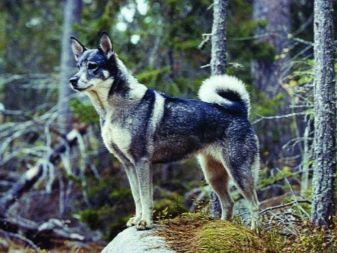
How to choose a puppy?
Choosing a thoroughbred husky puppy must be balanced and deliberate.
- Consider features of character and temperament any kind of likes. Assess your capabilities - whether you can cope with such an animal, whether you have enough time and energy for it. If you are a hunter and just an active person, then such a four-legged friend will suit you.
- Consider floor animal. Bitches are usually more agreeable and obedient. They are more persistent in their work than males, but they are in heat twice a year. Males do not have these problems. But, only having smelled a bitch in heat, they will give up all their affairs and rush to love adventures.
- If you follow the old hunting rules, then a good husky should have there are many scars in the sky, and the sky itself should be black.
- The potential of the dogs was determined and on the claws. If they are black or white, then the animal will be good at hunting small animals, and if they are variegated, they will hunt big game. Dogs with multi-colored claws are considered optimal.
- It is advisable to buy puppy from trusted producers, especially if you are looking for a good hunter. His parents must be aces in this matter. Buying such an animal without a pedigree is a big risk. This is a real "pig in a poke".
- When the puppies are still a month old, you can check them hearing. To do this, click your fingers while all the babies are sleeping and see who reacts first.
- Also check and the sense of smell of dogs. Bowls filled with food are placed next to the puppies.
- Reaction to sonorous clap the moments when babies are awake will be different. One individual will get scared, the other will not react at all, and the third will go to figure it out. It is the last puppy that should be bought.
- Puppies must be clean and healthy, with all documents. Their age should not be too young (newborn babies should not be taken).
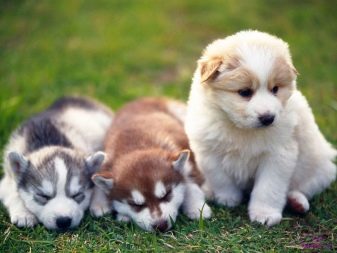

Maintenance and care
It will not be easy for an adult husky in an apartment. The dog will bark loudly and require constant physical exertion. Likes are comfortable in the cold, but it is hard for them in the heat, therefore it is not recommended to settle such a pet in an apartment. Many people keep these animals in open-air cages, where they are comfortable and calm.
The dog needs to be combed weekly. After each visit to the forest, this animal is required to wash and clean its hair from ticks, thorns, and thorns. Check the paws for wounds.
You need to walk with such an animal at least 4 hours a day. The pet should not be left alone and be left to itself. He must be released from the leash and allowed to run without a muzzle.
Keep your dog's eyes and ears clean.
You need to communicate and contact a lot with the dog so that it does not feel abandoned. Do not deprive the likes of physical activity and games. In such conditions, the pet will quickly wither away or begin to behave badly.
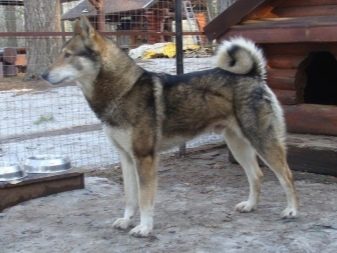
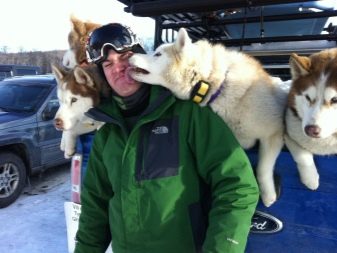
What and how to feed?
Puppies under 6 months of age need to be fed 5-6 times a day. When six months have passed, the baby will need to be given food 3 or 4 times. Adults should be fed twice a day - morning and evening. The dog should always have clean and fresh water freely available.
Animals of the described breed should not be eaten:
- smoked;
- fried;
- salty;
- pickled;
- spicy foods;
- peas;
- potatoes;
- White bread;
- sweets;
- baked goods;
- pasta.
The diet should contain other foods:
- pork;
- beef;
- poultry and rabbit meat;
- sea fish;
- dairy products;
- raw eggs (not often);
- steamed vegetables.
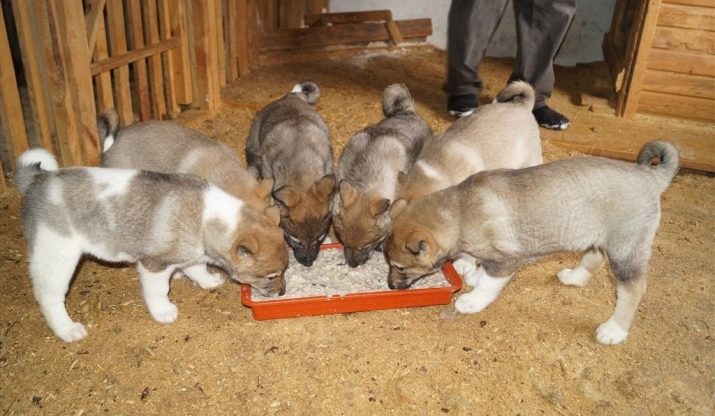
Education and training
Despite the fact that huskies are very smart and quick-witted, they still need to be properly educated. You need to start doing this as early as possible. It is extremely important to teach your pet all the necessary commands, which he must perform on demand.
Collar training is the first step. Put it on your pet, stroke it, and then treat it to a delicious treat. The next step is the leash. The dog should not chew or gnaw on it. As soon as the husky adapts to wearing the collar, it can be trained further and taught the commands "sit", "lie down", "voice", "die", "beside", "aport".
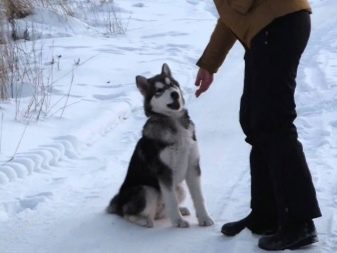
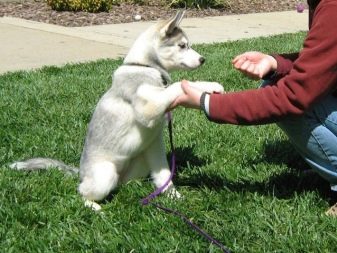
It is advisable to educate and train the husky in the fresh air. The ideal solution is to take the dog into the forest. Learning will be more productive and enjoyable if you do it in a playful way. If the dog obeys the command, be sure to praise him and reward him, pat him on the head. As annoyed as you are, never scream while raising your pet. Likes will not understand your aggressive behavior, as well as its reasons, but the relationship between you and your pet will noticeably deteriorate. The dog's trust will be lost, which will have a very bad effect on its further education.
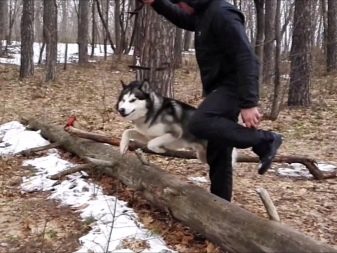
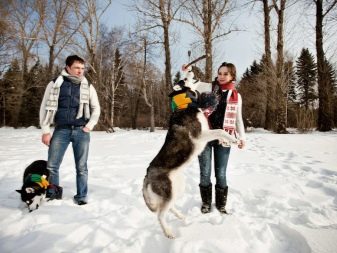
If you want to raise a professional hunter in a husky, you should first train it on small game. For example, it can be a hare or a squirrel. On this basis, the dog quickly adapts to hunting activities and in the future it will be easier for him to work with other animals.
When the husky turns 2 years old, you can safely take it with you to hunt for larger and stronger animals. It can be a moose or a bear. At such moments, the owner should be as attentive and vigilant as possible. The dog must always be under his strict supervision and supervision. Pay attention to how the animal reacts to the tracks left by the bear, as well as to its smell.

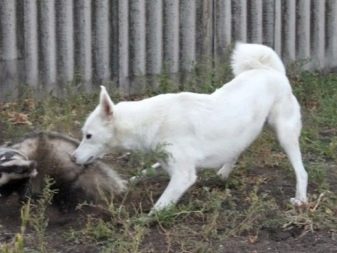
See the following video for tips on how to choose a husky puppy for hunting.


































